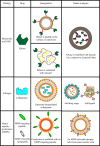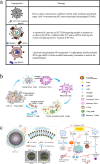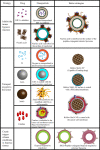Nanoparticle-based delivery systems modulate the tumor microenvironment in pancreatic cancer for enhanced therapy
- PMID: 34809634
- PMCID: PMC8607729
- DOI: 10.1186/s12951-021-01134-6
Nanoparticle-based delivery systems modulate the tumor microenvironment in pancreatic cancer for enhanced therapy
Abstract
Pancreatic cancer is one of the most lethal malignant tumors with a low survival rate, partly because the tumor microenvironment (TME), which consists of extracellular matrix (ECM), cancer-associated fibroblasts (CAFs), immune cells, and vascular systems, prevents effective drug delivery and chemoradiotherapy. Thus, modulating the microenvironment of pancreatic cancer is considered a promising therapeutic approach. Since nanoparticles are one of the most effective cancer treatment strategies, several nano-delivery platforms have been developed to regulate the TME and enhance treatment. Here, we summarize the latest advances in nano-delivery systems that alter the TME in pancreatic cancer by depleting ECM, inhibiting CAFs, reversing immunosuppression, promoting angiogenesis, or improving the hypoxic environment. We also discuss promising new targets for such systems. This review is expected to improve our understanding of how to modulate the pancreatic cancer microenvironment and guide the development of new therapies.
Keywords: Cancer-associated fibroblasts; Extracellular matrix; Immunosuppression; Nano-delivery systems; Pancreatic cancer; Tumor microenvironment.
© 2021. The Author(s).
Conflict of interest statement
The authors declare that they have no competing interests.
Figures






Similar articles
-
Nano-Drug Delivery Systems Targeting CAFs: A Promising Treatment for Pancreatic Cancer.Int J Nanomedicine. 2024 Mar 18;19:2823-2849. doi: 10.2147/IJN.S451151. eCollection 2024. Int J Nanomedicine. 2024. PMID: 38525013 Free PMC article. Review.
-
Modulation of cancer-associated fibroblasts by nanodelivery system to enhance efficacy of tumor therapy.Nanomedicine (Lond). 2023 Jun;18(15):1025-1039. doi: 10.2217/nnm-2023-0088. Epub 2023 Aug 10. Nanomedicine (Lond). 2023. PMID: 37584613 Review.
-
Current Strategies for the Treatment of Hepatocellular Carcinoma by Modulating the Tumor Microenvironment via Nano-Delivery Systems: A Review.Int J Nanomedicine. 2022 May 20;17:2335-2352. doi: 10.2147/IJN.S363456. eCollection 2022. Int J Nanomedicine. 2022. PMID: 35619893 Free PMC article. Review.
-
Extensive Review of Nanomedicine Strategies Targeting the Tumor Microenvironment in PDAC.Int J Nanomedicine. 2025 Mar 17;20:3379-3406. doi: 10.2147/IJN.S504503. eCollection 2025. Int J Nanomedicine. 2025. PMID: 40125427 Free PMC article. Review.
-
Breaking Down Barriers in Drug Delivery by Stromal Remodeling Approaches in Pancreatic Cancer.Mol Pharm. 2024 Aug 5;21(8):3764-3776. doi: 10.1021/acs.molpharmaceut.4c00329. Epub 2024 Jul 24. Mol Pharm. 2024. PMID: 39049481 Review.
Cited by
-
Emerging Nanotechnology in Preclinical Pancreatic Cancer Immunotherapy: Driving Towards Clinical Applications.Int J Nanomedicine. 2024 Jul 2;19:6619-6641. doi: 10.2147/IJN.S466459. eCollection 2024. Int J Nanomedicine. 2024. PMID: 38975321 Free PMC article. Review.
-
Surface saturation of drug-loaded hollow manganese dioxide nanoparticles with human serum albumin for treating rheumatoid arthritis.Drug Deliv. 2024 Dec;31(1):2380538. doi: 10.1080/10717544.2024.2380538. Epub 2024 Jul 23. Drug Deliv. 2024. PMID: 39044468 Free PMC article.
-
Passing of Nanocarriers across the Histohematic Barriers: Current Approaches for Tumor Theranostics.Nanomaterials (Basel). 2023 Mar 23;13(7):1140. doi: 10.3390/nano13071140. Nanomaterials (Basel). 2023. PMID: 37049234 Free PMC article. Review.
-
Nano-drug delivery system for pancreatic cancer: A visualization and bibliometric analysis.Front Pharmacol. 2022 Oct 18;13:1025618. doi: 10.3389/fphar.2022.1025618. eCollection 2022. Front Pharmacol. 2022. PMID: 36330100 Free PMC article.
-
Theranostic Applications of Glycosaminoglycans in Metastatic Renal Cell Carcinoma.Cancers (Basel). 2022 Dec 30;15(1):266. doi: 10.3390/cancers15010266. Cancers (Basel). 2022. PMID: 36612261 Free PMC article. Review.
References
Publication types
MeSH terms
Substances
Grants and funding
LinkOut - more resources
Full Text Sources
Medical

